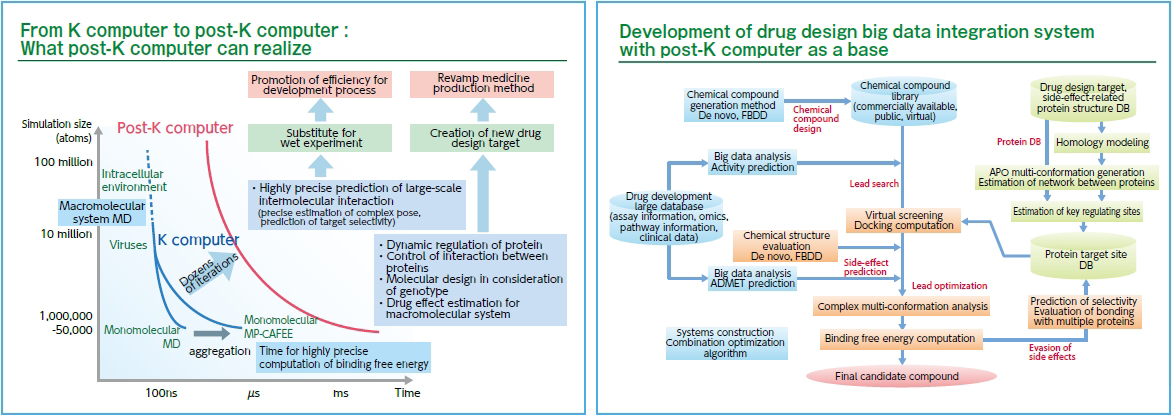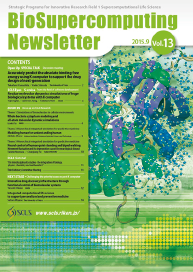Aiming at full-scale use by 2020, development of the post-K computer, a next-generation supercomputer, has started. 2020 is the year of the Tokyo Olympics, and we are going for the gold medal of science and technology with the post-K as our number one weapon.
The post-K development focuses on social as well as scientific issues, and we are developing a computational technique (application) that would bring innovation to nine priorities such as drug development, medicine, weather, manufacturing, space and so on. I am in charge of supervising "Innovative drug discovery infrastructure through functional control of biomolecular systems", which is one of these nine priorities. At this opportunity, let me introduce the study goal and an outline of our drug development with the post-K.
Over the past dozen years or so, the number of approvals of new medicines remains at the same level (around 20 items / yr) in the drug industry while research and development expenses continue rising, which has become a serious bottleneck. Therefore, "to accelerate new medicine development while holding down development cost" has become a most important issue for drug development and the medical field. Our final goal is to contribute to overcoming obstacles that the drug companies encounter, by using the overwhelming power of the post-K. In the post-K, we achieve a computational speed (molecular dynamics calculation) to simulate biomolecular behaviors that is dozens of times faster than that of the K computer. It allows us to aim at reproducing in vivo molecule behaviors over longer time periods (millisecond level), and promoting drug development simulation for more molecules in vivo. Based on such development work, we are exploring a new drug design method to which dynamic control of disease-causing proteins and multiple drug development-related proteins are added. Specifically, we are developing new structural life sciences and a next-generation drug development computational technique (Subtheme B) through the development of a new molecular simulation technique that allows operation of the post-K at its maximum computational power (Subtheme A). Moreover, we aim to establish a highly precise and ultra-high speed innovative drug development computational base while developing an integrated system for which these core computation techniques are connected along the drug development computation flow (Subtheme C). Use of the drug development computational base with the post-K as a key in actual pharmaceutical scenarios leads to promotion of efficiency in drug development processes. For example, the experimental processes of past drug development are replaced by computer simulations, and this dramatically reduces the development cost of medical supplies and thus medical cost. We are also exploring an innovative approach for new drug development, such as drugs for dynamic functional control of target proteins, epigenetic drug development that targets the macromolecular assemblage of protein-nucleic acids, and systemic drugs based on the simulation of a super large-scale biological system. It allows creation of new medicines that so far were difficult to develop, and speeds-up development of pharmaceuticals. As a result, they are expected to contribute to the needs of patients for new medicines.


Working with the present the K computer, I received a very strong impression that greatly changed my view of computational sciences. The supercomputer, on which the nation put high priority, not only brings industrial benefits and lets us reach the top of world supercomputer rankings, but also gives a big dream to young people who are the scientists of tomorrow. Indeed, it is often said that supercomputers have the performance of future general purpose computers that will be available 15 years from now. This means that the post-K, which is to be completed in 2020, brings us the future computational environment of 2035. Therefore, we have great expectations of the post-K and a huge responsibility. We, who are involved in the field of drug development, are vigorously advancing research and development so as to construct of a world-class drug development computational base. We hope you will not simply look at the post-k as a machine available in 2035 evaluated by 2015 viewpoints, but continuously provide us with your prospective and constructive opinions. Your continued support is greatly appreciated for successful development of the post K, which will support continuous development of industry and science in Japan.

![]()
Integrated computational life science to support personalized and preventive medicine


















